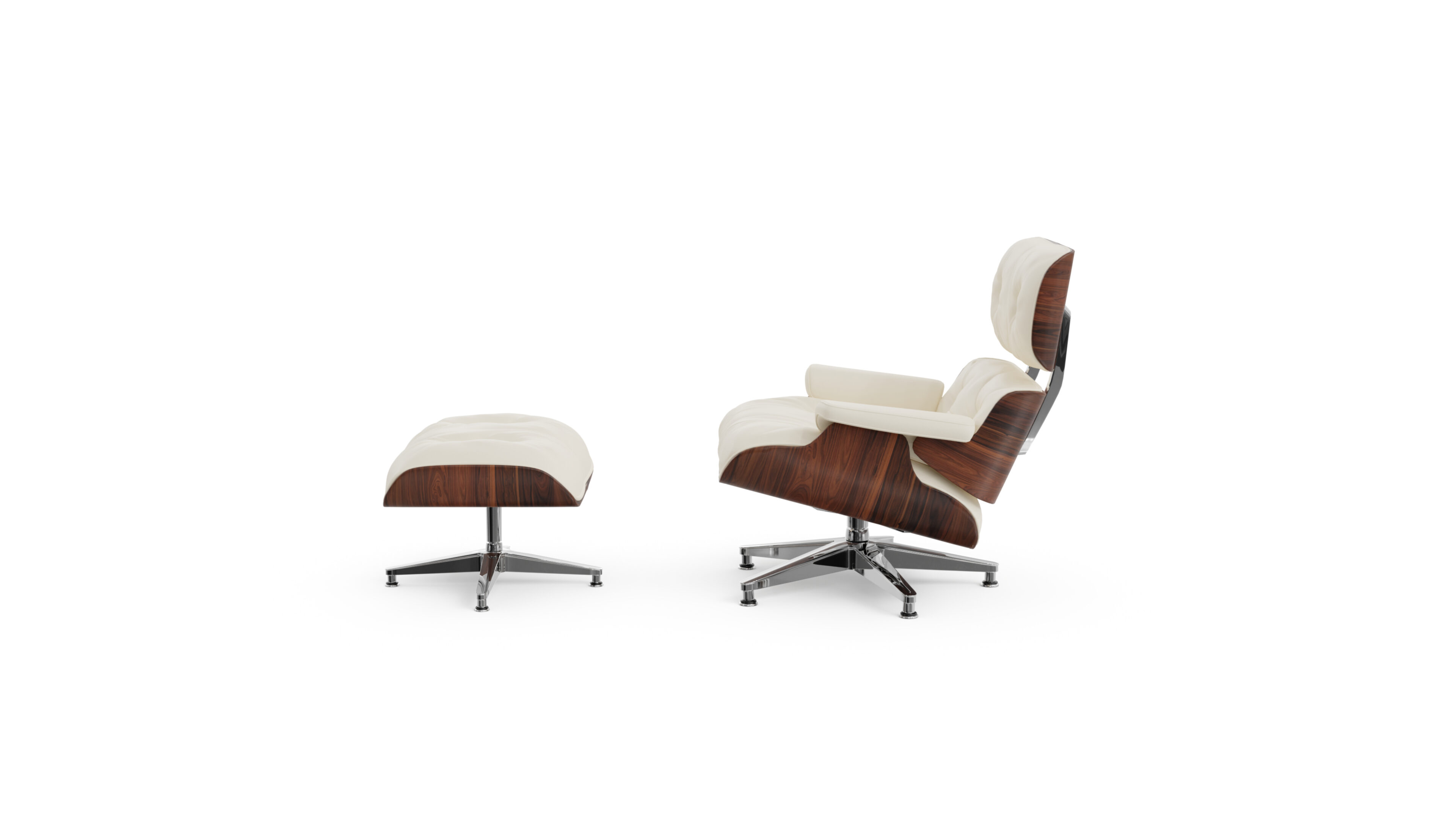
Pierre Jeanneret Biography
Pierre Jeanneret (1896-1967) was a Swiss architect and designer known for his significant contributions to modernist furniture and architecture. He began his career collaborating with his cousin, Le Corbusier, and Charlotte Perriand on the LC series, including the LC2 and LC3 armchairs, unveiled at the 1929 Salon d’Automne exhibition “Equipment for Living” in Paris. Jeanneret is renowned for his work in Chandigarh, India (1951-1965), where he designed and oversaw the production of functional furniture for the city’s public buildings. His designs include the iconic Committee Chair, Kangaroo Chair, and Capitol Complex Chairs, all characterized by their use of local materials and simple, geometric forms. Pierre Jeanneret’s versatility in design, architecture, and material usage has left an enormous mark on global design, with his work continuing to gain prominence and recognition to this day.
Early Life and Education
Born in 1896 in Geneva, Switzerland, Pierre Jeanneret grew up in an environment that fostered creativity and innovation. He was the cousin of Charles-Édouard Jeanneret-Gris, who would later become known as Le Corbusier, one of the pioneers of modern architecture. This family connection would prove instrumental in shaping Jeanneret’s career. Pierre studied at the École des Beaux-Arts in Geneva, where he developed a strong foundation in both architecture and design principles.
Career and Achievements
Jeanneret’s professional career began in earnest when he started collaborating with his cousin Le Corbusier in 1922. This partnership would last for over two decades and result in numerous groundbreaking projects. One of their most notable early collaborations was the LC series of furniture, designed in conjunction with Charlotte Perriand. The LC2 and LC3 armchairs, unveiled at the 1929 Salon d’Automne exhibition in Paris, became icons of modernist design, embodying the principles of functionality and aesthetic simplicity that characterized the movement.
While Jeanneret’s work with Le Corbusier was significant, it was his independent project in Chandigarh, India, that truly cemented his legacy. In 1951, following India’s independence, Prime Minister Jawaharlal Nehru commissioned Le Corbusier to design a new capital city for the state of Punjab. Le Corbusier brought in Jeanneret to oversee the project, and it was here that Jeanneret’s talents truly flourished.
Over the course of 15 years in Chandigarh, Jeanneret not only contributed to the city’s architectural planning but also designed a wide range of furniture for the city’s public buildings. His designs, including the Committee Chair, Kangaroo Chair, and Capitol Complex Chairs, were characterized by their use of local materials (primarily teak and cane) and simple, geometric forms. These pieces were not just functional but also reflected a deep understanding of the local climate, culture, and available resources.
Jeanneret’s work in Chandigarh was revolutionary in its approach to sustainable and contextual design, long before these concepts became mainstream in the design world. His furniture was produced locally, using traditional craftsmanship techniques combined with modern design principles, creating a unique fusion of East and West.
Signature Designs
Pierre Jeanneret’s portfolio includes a wide range of designs, from collaborative projects to individual creations. Some of his most notable works include:
1. LC2 and LC3 Armchairs (1928): Designed in collaboration with Le Corbusier and Charlotte Perriand, these iconic pieces epitomize modernist furniture design.
2. Committee Chair (1953-54): A simple yet elegant chair designed for Chandigarh’s administrative buildings, featuring a distinctive V-shaped leg structure.
3. Kangaroo Chair (1955): A low-slung lounge chair with a distinctive profile, designed for relaxation in Chandigarh’s climate.
4. Capitol Complex Chair (1955-56): A series of chairs designed for the Capitol Complex in Chandigarh, featuring clean lines and functional forms.
5. Library Table (1960): A simple yet elegant table designed for Chandigarh’s libraries, showcasing Jeanneret’s mastery of proportion and material.
Design Philosophy and Approach
Jeanneret’s design philosophy was rooted in the principles of modernism, emphasizing functionality, simplicity, and the honest use of materials. However, his approach evolved over time, particularly during his work in Chandigarh, to incorporate a deep respect for local context and resources.
One of the key aspects of Jeanneret’s approach was his attention to the relationship between furniture and architecture. He believed that furniture should complement and enhance the spaces it inhabits, rather than dominating them. This holistic view of design is evident in both his collaborative work with Le Corbusier and his independent projects in Chandigarh.
Jeanneret was also a pioneer in sustainable design, although this term wasn’t widely used during his lifetime. His work in Chandigarh demonstrated a remarkable sensitivity to local materials and craftsmanship. By using locally available woods and traditional techniques, he created furniture that was not only functional and beautiful but also deeply rooted in its context.
Another important aspect of Jeanneret’s philosophy was his belief in the democratization of design. Many of his pieces for Chandigarh were designed to be easily reproducible and affordable, reflecting his commitment to creating quality design for all, not just the elite.
Legacy and Influence
Pierre Jeanneret’s influence on modern design is profound and multi-faceted. His early work with Le Corbusier helped establish the aesthetic principles of modernist furniture design, influencing countless designers in the decades that followed.
However, it is perhaps his work in Chandigarh that has had the most lasting impact. Jeanneret’s approach to design in India – his use of local materials, his respect for traditional craftsmanship, and his ability to create furniture that was both modern and contextually appropriate – was ahead of its time. Today, as the design world grapples with issues of sustainability and cultural sensitivity, Jeanneret’s work in Chandigarh serves as a powerful example of how these concerns can be addressed.
In recent years, there has been a resurgence of interest in Jeanneret’s work, particularly his Chandigarh designs. These pieces, once considered utilitarian office furniture, are now highly sought after by collectors and have been featured in major design exhibitions around the world.
Jeanneret’s legacy extends beyond his physical designs. His approach to design – holistic, contextual, and socially conscious – continues to inspire designers today. As the design world increasingly recognizes the importance of sustainability and cultural relevance, Jeanneret’s work serves as a model of how these principles can be effectively integrated into design practice.
Pierre Jeanneret FAQs
What is Pierre Jeanneret best known for?
Pierre Jeanneret is best known for his collaboration with Le Corbusier on the LC series of furniture and his independent work in Chandigarh, India, where he designed furniture for the city’s public buildings, including the iconic Committee Chair and Kangaroo Chair.
What is the significance of Jeanneret’s work in Chandigarh?
Jeanneret’s work in Chandigarh is significant for its innovative use of local materials, its fusion of modern design principles with traditional craftsmanship, and its approach to creating functional, affordable furniture for public use. This work is now recognized as a pioneering example of sustainable and contextual design.
How did Jeanneret’s approach to design differ from his contemporaries?
While Jeanneret embraced modernist principles, his approach, particularly in Chandigarh, was distinguished by its sensitivity to local context, materials, and craftsmanship. He created designs that were modern yet deeply rooted in their environment, an approach that was ahead of its time.
What is the LC series?
The LC series is a collection of furniture designed by Le Corbusier, Pierre Jeanneret, and Charlotte Perriand in the late 1920s. It includes iconic pieces like the LC2 and LC3 armchairs, which are considered classics of modernist furniture design.
























